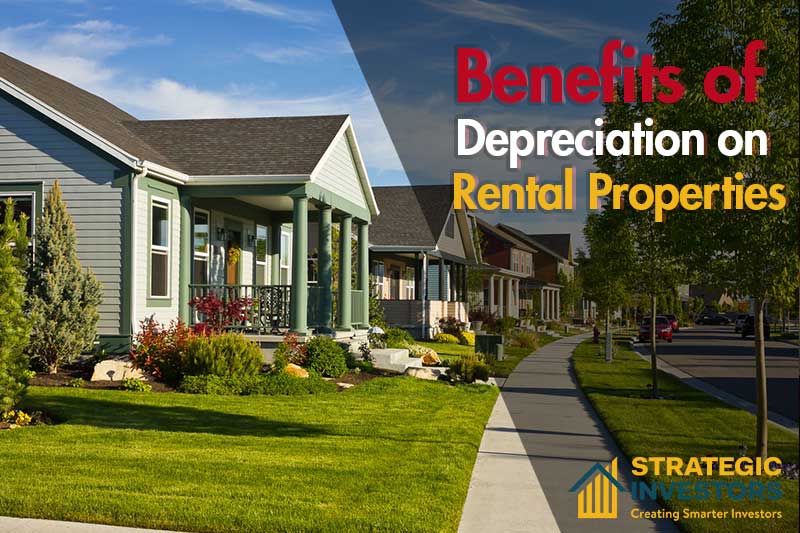
Did you know that depreciation on rental properties can be a powerful tax-saving tool for property investors? In this blog post, we’ll dive into the world of depreciation, exploring the different types of deductions, calculation methods, and the claiming process. By the end, you’ll have a solid understanding of how to leverage depreciation to maximize your tax benefits and improve your financial situation.
Key Takeaways
- Depreciation on rental properties can reduce taxable income and increase cash flow.
- Capital works deductions are available for buildings constructed after 15 September 1987, while plant & equipment deductions vary depending on the asset’s effective life.
- Professional advice should be sought to optimize depreciation claims and plan for capital gains tax liability.
Understanding Depreciation on Rental Properties
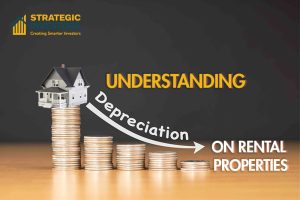
There are two main types of rental property assets eligible for depreciation: capital works and capital allowances (e.g., plant and equipment). Claiming depreciation allows property investors to enjoy benefits such as reduced taxable income, increased cash flow, and long-term financial gains.
What is Depreciation?
Depreciation is the process of accounting for the reduction in value of a rental property due to wear and tear over time, also known as investment property depreciation. There are two categories of depreciation: Division 43 Capital Allowances, which includes the construction of buildings or alterations to existing buildings, and Division 40 Depreciating Assets, which covers easily removable fixtures and fittings found within the property, often referred to as depreciating assets.
For property investors aiming to maximize their tax deductions, grasping the different categories of depreciation is pivotal.
Why Depreciation Matters
Depreciation matters because it can reduce taxable income, increase cash flow, and provide long-term financial benefits for property investors. Claiming depreciation enables property owners to diminish their taxable income, thereby reducing their tax liabilities.
The Australian Taxation Office (ATO) recognizes certain items as depreciable assets. These include:
- Carpet
- Blinds
- Air conditioners
- Hot water systems
- Smoke alarms
- Ceiling fans
As a property investor, it’s essential to understand the importance of depreciation and how it can improve your financial situation.
Types of Depreciation Deductions

Comprehending these types of deductions is key when claiming depreciation on your rental property. Being aware of available deductions allows you to optimize your tax benefits and enhance your overall financial condition.
Capital Works Deductions
Capital works deductions refer to the construction cost of a property that can be claimed over a period of 40 years at a fixed rate. The capital works deduction is applicable to owners of residential properties that began construction after 15 September 1987. The rate of capital works deductions is 2.5% per annum for a maximum of forty years, and the cost base is the construction expenditure of the property.
These claim deductions encompass claims for wear and tear that occur to the structure of the property and any fixed items, such as:
- the roof
- walls
- doors
- kitchen cupboards
- bathroom tubs
- toilet bowls
Plant & Equipment Deductions
Plant & equipment deductions apply to removable fixtures and fittings within the property, with the deduction rate varying based on the asset’s effective life. The ATO determines the effective life of each asset, and depreciation deductions are calculated accordingly.
Bear in mind that the 2017 legislation amendments affected depreciation for plant and equipment assets. Hence, property investors should seek advice from a tax professional to comprehend any possible restrictions that may apply to their specific situation.

Methods for Calculating Depreciation
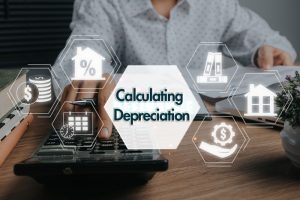
An investor should assess elements such as anticipated yearly incomes, the diminishing value and opportunity cost of current versus future cash, and future utilization of the property when determining a depreciation method. Each method presents distinct advantages for property investors, hence the importance of selecting the one that aligns best with your financial objectives.
Prime Cost Method
The prime cost method provides equal tax deductions annually over the asset’s effective life, thereby ensuring a consistent rate of depreciation. This method allows for a more even distribution of deductions and returns for the investor throughout the asset’s lifetime.
The formula for calculating depreciation using the prime cost method is: Asset’s cost multiplied by (days held divided by 365) multiplied by (100% of asset’s effective life).
Diminishing Value Method
The diminishing value method involves applying the designated depreciation rate to the depreciated value of the asset each year in a continuous manner. The investor can gain much greater tax deductions and returns in the beginning. Later on, these advantages will decrease progressively.
The formula for the diminishing value method is: Base value X (days held/365) X (200%/asset’s effective life).
It is important to remember that leap years have an extra day. This means the number of days can reach 366. The formula to determine the base value of an asset held prior to 10 May 2006 is Base value X (days held/365) X (200%/asset’s effective life). This formula applies regardless of the asset’s initial intention or current use.
Obtaining a Depreciation Schedule

Knowing how to acquire a depreciation schedule is fundamental for claiming depreciation on your rental property and optimizing your tax benefits. Let’s dive into the role of a quantity surveyor and the associated costs and timeframes for obtaining a depreciation schedule.
The Role of a Quantity Surveyor
A quantity surveyor is an expert who professionally assesses the value of construction work and provides a report on the rate of depreciation claimable on a property. Engaging one is necessary for accurately claiming depreciation on a property.
A quantity surveyor can help you estimate construction costs and prepare a depreciation schedule that will maximize your tax benefits.
Costs and Timeframes
The fee for a depreciation schedule is contingent upon the type of property (commercial or residential), whether the property is brand new or established, and how much information is available.
The completion time of a depreciation report can range from three days to a fortnight. It may take up to two weeks for the report to be ready. Remember to consider these costs and timeframes when planning to claim depreciation on your rental property.
Claiming Depreciation on Your Tax Return
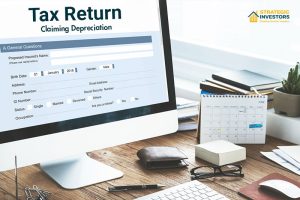
Working with an accountant can help optimize deductions and ensure that you are taking advantage of all available tax benefits. An accountant can also elucidate the tax ramifications of claiming depreciation on your rental property.
Record-Keeping Essentials
Property investors must maintain detailed records for tax purposes, including:
- Records of the purchase of depreciable assets
- The date of purchase and cost
- Improvements or additions
- Depreciation calculations
- The date of disposal or sale
These records are important for accurately reporting income, expenses, and depreciation claims.
These records should be stored for a minimum of 5 years from the date of lodging the tax return.
Working with an Accountant
An accountant can provide guidance on tax laws, facilitate the claiming of depreciation deductions, and advise on potential capital gains tax implications. Collaborating with an accountant to claim depreciation on a tax return involves the following steps:
- Engaging a quantity surveyor
- Procuring a Tax Depreciation Schedule
- Consulting with the accountant
- Furnishing necessary documentation
- Including the depreciation deductions in the tax return.
Working with an accountant ensures that you’re maximizing your tax benefits and staying compliant with tax laws.
Depreciation Considerations for Older Properties

Property investors should consider these factors when claiming depreciation on older properties. Understanding the limitations and opportunities enables you to make informed decisions and optimize your tax benefits.
Claiming Capital Works Deductions
Older properties may still be eligible for capital works deductions if built after 15 September 1987, with a depreciation rate of 2.5% per annum for a maximum of forty years. These deductions encompass claims for wear and tear that occur to the structure of the property and any fixed items, such as:
- the roof
- walls
- doors
- kitchen cupboards
- bathroom tubs
- toilet bowls
Plant & Equipment Deductions for Older Properties
Property investors can claim depreciation on new assets in older properties, but may face limitations on previously used assets due to the 2017 legislation amendments. These amendments stipulate that owners of pre-owned residential properties are not allowed to depreciate “second-hand assets” such as ovens, dishwashers, and carpets.
It’s essential to consult a tax professional to understand any limitations that may apply to your specific situation.
Impact of Depreciation on Capital Gains Tax
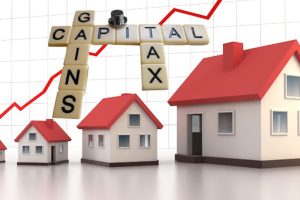
To reduce your tax liability, working with a tax professional to anticipate potential capital gains tax implications and devise strategies that align with your financial situation and goals is vital.
Depreciation Recapture
Depreciation recapture is a tax consequence that occurs when a property is sold for a gain, potentially resulting in increased capital gains tax due to a decreased cost base. This process involves the IRS collecting income tax on the gain realized from the sale of depreciable property, which is reported as ordinary income for tax purposes.
For property investors planning for potential tax implications when selling a property, comprehending depreciation recapture is imperative.
Planning for Capital Gains Tax
Working with a tax professional can help property investors navigate tax laws, plan for potential capital gains tax implications, and create strategies to reduce their tax liability.
By understanding the impact of depreciation on capital gains tax and implementing effective tax strategies, property investors can reduce their tax liability and enhance their financial gains.
Summary
In conclusion, understanding and claiming depreciation on rental properties is a powerful tax-saving tool for property investors. By exploring the different types of deductions, calculation methods, and claiming processes, you can maximize your tax benefits and improve your financial situation. Don’t miss out on the potential tax savings – consult a tax professional and start leveraging depreciation today.
Frequently Asked Questions

How much depreciation can I claim on a rental property?
You can claim depreciation at a rate of 2.5% per year for 40 years on a rental property built after 15 September 1987. This means that for a property originally costing $100,000 to build, you could claim $2,500 each year until 2030.
Additionally, depreciation for plant items is calculated based on the effective life span of the relevant asset.
How many years can you depreciate a rental property in Australia?
You can depreciate rental property in Australia for up to forty years with a BMT Tax Depreciation Schedule and its one-off, 100% tax deductible fee.
What does depreciation mean in housing?
Depreciation in housing refers to the process of deducting the costs of buying and improving a property over its useful lifetime, as well as the offset of investment property’s decline in value from taxable income.
It includes deductions for capital works expenditure such as building or extensions and the decrease in value of the contents.
What types of assets can be depreciated on a rental property?
Rental properties can depreciate the building structure and any removable fixtures and fittings associated with it.
Can I claim depreciation on an older rental property?
Yes, you can claim depreciation on an older rental property, but there may be limitations depending on its age and assets.












